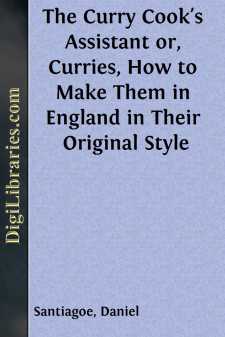Categories
- Antiques & Collectibles 13
- Architecture 36
- Art 48
- Bibles 22
- Biography & Autobiography 813
- Body, Mind & Spirit 142
- Business & Economics 28
- Children's Books 17
- Children's Fiction 14
- Computers 4
- Cooking 94
- Crafts & Hobbies 4
- Drama 346
- Education 46
- Family & Relationships 57
- Fiction 11829
- Games 19
- Gardening 17
- Health & Fitness 34
- History 1377
- House & Home 1
- Humor 147
- Juvenile Fiction 1873
- Juvenile Nonfiction 202
- Language Arts & Disciplines 88
- Law 16
- Literary Collections 686
- Literary Criticism 179
- Mathematics 13
- Medical 41
- Music 40
- Nature 179
- Non-Classifiable 1768
- Performing Arts 7
- Periodicals 1453
- Philosophy 64
- Photography 2
- Poetry 896
- Political Science 203
- Psychology 42
- Reference 154
- Religion 513
- Science 126
- Self-Help 84
- Social Science 81
- Sports & Recreation 34
- Study Aids 3
- Technology & Engineering 59
- Transportation 23
- Travel 463
- True Crime 29
The Curry Cook's Assistant or, Curries, How to Make Them in England in Their Original Style
by: Daniel Santiagoe
Description:
Excerpt
The author of this little work has asked me to write him a Preface, and I gladly do so, especially if it will help to find him buyers, as well as readers, who will put into practice the admirable receipts he offers to gourmets and others. For my own part I can speak with some authority—indeed the best—as to the excellence of Santiagoe's Curries, for I am among the fortunate few who have tasted them in England.
I was particularly struck by a remark which Santiagoe made when I asked him what he would like me to write in his little book. Some authors might have replied “Speak up for my Curries!” others might have said, “Say a good word for my book;” but he, in the fulness of gratitude, said, “Praise my Masters.” He then went on to speak of how Mr. Shand and Mr. Haldane had brought him and his fellow-servants all the way from Ceylon to England.
It is only fair to point out that the English of this little book is not “English as she is spoken,” but represents the expression of Santiagoe in its native costume—it is Tamil Anglicised by Santiagoe himself. As Santiagoe says, “I like broken English, because ladies gentlemen like that.” The author is a native of Trichinopoly. His grandfather and uncle were distinguished drummers in Indian infantry regiments—in other words, they were masters of the tom-tom. He has lived all his life in Ceylon,
and for the last seven years—that is, since he was sixteen—has been in the service of English residents, of whom he appears to have nothing but pleasant recollections. It would seem that this will be the case in his experience of England, whither he has come with others as waiter at the Ceylon Tea Rooms in the Liverpool Exhibition—though he told me with much modesty that“people were very kind, but he supposed the Ceylon servants were a novelty.”It is, to say the least, highly creditable to Santiagoe that, with many duties to perform, and these amid the distracting influences of our Western civilization, he should have compiled this useful little guide to the art of Curry cooking. The spirit of Brillat-Savarin and of Soyer is stronger than the ephemeral attractions of an exhibition. Let us hope Santiagoe's enterprise will be more lasting than these; that it will achieve its aim in popularizing Ceylon Curries in this country; and that his “Book on Curries” will pass through many editions, and bring him the “little fortune” he deserves.
(Signed) A. EGMONT HAKE,
Author of “General Gordon's Journal at Khartoum;” Editor of “The Story of Chinese Gordon,” etc., etc.; Commissioner of War Trophies, Royal Jubilee Exhibition, Liverpool, 1887.
COPY OF THE NOTE OF MY FIRST EDITION ON CURRIES.
I beg to bring the following Receipts to Curries, etc. I hope it will be handy to ladies, housekeepers, cooks, etc. I only mention the easy way of making it in England, for scarcity of fresh and pure Curry stuffs none procurable. Still, it is very troublesome to grind the Curry stuffs without a Curry stone, which is very common to a native Cooly of India. No native houses without a Curry stone. The way the native girls, etc., grind the Curry stuffs will be an astonishment to European ladies. The best way to grind the Curry powder in England, by hard stone made mortar or pounder, but the best and easy way is to buy from your respected grocers, which, I should say, ought to be of two colours, one is brown and the other is yellow, and the red is cayenne pepper (if required hot Curries)....


